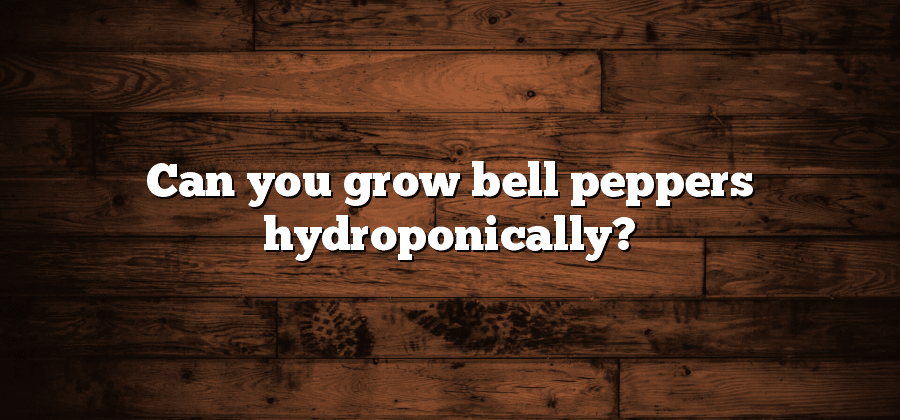Providing Nutrient Solution for Bell Pepper Growth
Nutrient solutions play a crucial role in the growth and development of bell pepper plants in hydroponics systems. Bell peppers have specific nutrient requirements that must be carefully met to ensure optimal growth and yield. Understanding these requirements is the first step in providing the right nutrient solution for your plants.
Bell peppers require a balanced mix of essential nutrients, including nitrogen, phosphorus, potassium, calcium, magnesium, and micronutrients. These nutrients are responsible for various physiological processes in the plant, such as leaf and stem development, flowering, fruit set, and fruit maturation. To provide the correct nutrient solution, it is important to analyze the nutrient levels in your hydroponic system and adjust accordingly. This can be done through regular testing of the nutrient solution using a reliable testing kit or by consulting with an expert in hydroponic plant nutrition. By providing the appropriate nutrient solution, you can ensure that your bell pepper plants receive the necessary elements for healthy growth and abundant harvest.
1) Understanding Nutrient Requirements
Bell peppers, like all plants, have specific nutrient requirements to support their growth and development. Understanding these requirements is crucial for successful cultivation. The primary nutrients needed by bell peppers are nitrogen (N), phosphorus (P), and potassium (K). Nitrogen is essential for leaf and stem growth, phosphorus promotes root development and flowering, while potassium aids in overall plant health and fruit production.
Aside from the primary nutrients, bell peppers also require secondary nutrients and micronutrients. Secondary nutrients include calcium (Ca), magnesium (Mg), and sulfur (S), which are needed in smaller quantities compared to the primary nutrients but are still vital for optimal growth. Micronutrients such as iron (Fe), zinc (Zn), manganese (Mn), copper (Cu), boron (B), and molybdenum (Mo) are essential for the various metabolic processes within the plant.
To provide bell peppers with the necessary nutrients, growers often use hydroponic nutrient solutions. These solutions are carefully formulated to match the specific nutrient requirements of the plants. It is crucial to measure and adjust the nutrient solution’s composition regularly to ensure that the plants have access to an optimum balance of nutrients. Adhering to the proper nutrient mix will enable bell peppers to thrive in a hydroponic system and produce healthy, flavorful fruits. Understanding these nutrient requirements and providing the right nutrient solution is the first step towards successful bell pepper production.
2) Properly Mixing Nutrient Solutions
When it comes to properly mixing nutrient solutions for bell pepper growth in hydroponics, attention to detail is key. Firstly, it is important to carefully measure out the required amounts of each nutrient. The precise measurements will vary based on the specific nutrient requirements of bell pepper plants at different stages of growth. Consulting a reputable source or seeking advice from experienced hydroponic growers can provide valuable guidance in determining the appropriate nutrient ratios.
Once the nutrient amounts have been determined, they should be thoroughly dissolved in water. It is crucial to dissolve the nutrients completely to ensure that the plants can easily absorb them. Using warm water can aid in dissolving the nutrients more effectively. Stirring the mixture gently and consistently will also help to achieve a homogeneous solution. Avoiding sudden temperature changes and allowing the solution to settle before use can further enhance the nutrient availability for the bell pepper plants.
Overall, properly mixing nutrient solutions is an essential aspect of successful bell pepper growth in hydroponics. By carefully measuring and dissolving the nutrients in water, growers can provide their plants with the precise nutrient ratios needed for optimal growth and productivity. Effective nutrient mixing techniques will undoubtedly contribute to the overall health and yield potential of bell pepper plants in a hydroponic system.
Pruning and Training Bell Pepper Plants in Hydroponics
Bell pepper plants in hydroponics require regular pruning to maximize yield and promote healthy growth. Pruning involves removing unwanted shoots, leaves, and flowers to redirect the plant’s energy towards fruit production. By removing excess foliage, the plant can focus its resources on developing larger and tastier peppers. Additionally, pruning increases air circulation and reduces the risk of diseases caused by moisture accumulation. It is essential to prune consistently throughout the growing season to maintain the plant’s shape and productivity.
Training bell pepper plants in hydroponics involves supporting the stems and branches as they grow. This ensures that the plants stay upright and minimizes the risk of breakage under the weight of the fruit. Using stakes, trellises, or cages can provide the necessary support to keep the plants properly trained. Training not only helps protect the plant but also allows for better sunlight penetration and airflow, promoting overall plant health. Regular monitoring and adjusting of the training structures are necessary to accommodate the plant’s growth throughout its lifespan.
1) Pruning for Maximum Yield
Pruning is a crucial practice in maximizing the yield of bell pepper plants in hydroponic systems. By selectively removing certain plant parts, gardeners can redirect energy towards the growth of fruits, resulting in increased yields. The primary aim of pruning is to create a well-balanced plant structure that allows for adequate air circulation and light penetration throughout the canopy.
One key aspect of pruning is the removal of lateral shoots, or suckers, that develop in the axils of leaves. These suckers compete for nutrients and energy with the main stem, diverting resources that could be better utilized for fruit development. By consistently removing these side shoots, gardeners encourage the plants to focus their energy on producing larger, high-quality peppers. Additionally, removing lower leaves that touch the ground can help prevent the spread of diseases and improve air circulation, reducing the risk of fungal infections.






